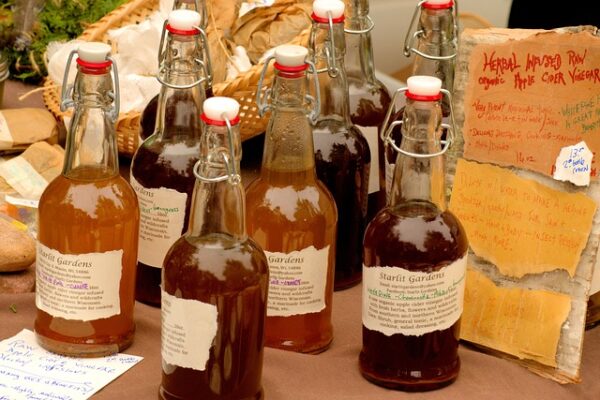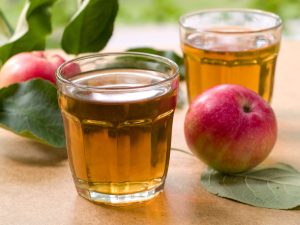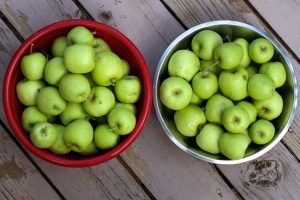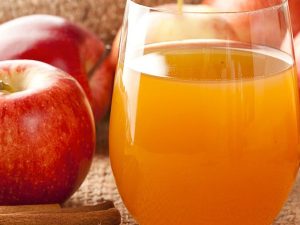This article looks at continuing the process after producing cider to produce cider vinegar.

From a biochemical viewpoint, cider vinegar is the next step after cider itself on the road which converts sugar through to alcohol, thence to acetic acid and finally to carbon dioxide and water. At each step, the organisms involved gain energy – this, after all, is why they do what they do and their metabolism is very little different from our own in many respects. Animals, however, do not stop at the alcohol or acetic acid stage. Some micro-organisms do and we can take advantage of this to provide the products that we want. Vinegar is simply a dilute solution (about 5%) of acetic acid which has been converted from a corresponding quantity of alcohol.
To make cider vinegar we need to start with a fully fermented dry cider with a minimum 5% alcohol content. Sulphur dioxide should not have been added for storage, because this will inhibit the conversion to acetic acid. Contrary to all good cidermaking practice, we then need to leave the cider in a vessel with plenty of access to air and to ensure that Acetobacter are present. These organisms, fatal to good cider, are just what we need for vinegar. The traditional set-up for vinegar-making is known as the Orleans or barrel process and consists of a barrel laid on its side, three-quarters full of liquid with open access to air. The bung hole is lightly plugged or covered with gauze so that oxygen can get in but flies cannot! A ‘mother’ of Acetobacter floats on the surface and converts the alchol to acetic acid at the rate of roughly 1% per week if the weather is warm enough. It really won’t work if the temperature is below about 20º C, and goes much faster if it’s warmer. So a cider with an alcohol of 6% could give a vinegar of 6% acetic acid in a couple of months or so. Two-thirds of the barrel is then drawn off as vinegar, fresh cider is added, and the cycle is repeated. Modern vinegar factories do not use this method, because it is far too slow. They use big fermenters with forced aeration and a very high population of acetic acid bacteria, which can convert a wine or cider to a vinegar within a few hours. Efficient as the big fermenters may be, the advantage of the barrel process is that is has no moving parts and virtually nothing to go wrong. You just have to wait a lot longer!
Setting up the system is the hardest part. Whereas it is easy to go out and buy a good fermenting yeast, it is much more difficult to buy a ‘mother’.Traditionally, a vinegar barrel was always started by adding an inoculum of old vinegar from somewhere else. But in most cases it will be no good for you to buy a bottle of supermarket vinegar and hope to use it as a starter, since most modern commercial vinegars are pasteurised or sterile filtered and the Acetobacter do not survive. However, if you hunt around the specialist food stores, you might find vinegar which contains live mother, and you can use that. Pieces of ‘mother’ can also be purchased from home winemaking suppliers in the USA and in Germany, but nobody sells them in the UK, it seems. Acetobacter cultures are now available by mail order from Brouwland in Belgium, however, and although I have not tried them I see no reason why they wouldn’t work as a starter to develop ‘mother’.
If you wait long enough, though, wild acetic acid bacteria will almost certainly find their way in. Probably the best plan is to keep an open jar of cider, covered with a coarse mesh, in a warm place for as many weeks as it takes for a ‘mother of vinegar’ to form. In this case the presence of fruit flies (Drosophila) may be quite helpful since they tend to carry Acetobacter around with them. It may be wise to add about 25% of commercial cider or wine vinegar to the jar to inhibit other non-acetifying organisms. Make sure that any vinegar you add does not contain any SO2 or other preservative – this will be stated on the label. The ‘mother’ is simply a floating mat of cellulose made by the acetobacter themselves to keep them close to the surface, since air is essential for their existence. Once you are sure you have a genuine gelatinous ‘mother’ and not a powdery film yeast, and you can really smell the vinegar, you can pitch it into your barrel with the required amount of still dry cider and your Orleans process will be under way. Keep it warm, up to 30° C if you can, for best results. Don’t worry if the ‘mother’ drops to the bottom of the vat when you transfer it – a new ‘mother’ will soon grow on the top.
Another method for generating a vinegar starter is to make a heap of fresh apple pomace, keeping it moist and preferably warm for several weeks. During this time it will ferment its residual sugars and natural acetobacter should then proliferate. Once it smells quite vinegary, the pomace can be squeezed out through a muslin bag and the resultant liquor (rich in acetobacter) can be used as a starter which will eventually develop a ‘mother’.
DO NOT, WHATEVER YOU DO, USE THE SAME EQUIPMENT AND VESSELS FOR VINEGAR MAKING AS FOR CIDER. The risk of cross-infection is just too great and it is not worth spoiling your good cider by trying to economise in this way. Keep both operations entirely separate! If you are making vinegar close to your cider, as you probably will be, it is doubly important that your cider-making kit be properly cleaned and sterilised anyway.
Once the vinegar is made it can simply be run into bottles for use. On a domestic scale there is no need for pasteurisation. Cider vinegar from the Orleans process is generally fairly clear but it may develop a further haze on storage in bottle. This is due partly to renewed growth of bacteria and partly to polymerisation of tannin. You can fine the vinegar with gelatin/bentonite if necessary to reduce an existing or a potential haze. If it is then important to prevent further clouding, SO2 at 50 ppm (i.e. 2 Campden tablets per 10 litres) may be added just before bottling, and this will inhibit both types of spoilage process.
Vinegar vats occasionally become infected with vinegar ‘eels’. These are small and transparent nematode worms a few millimetres long, which live on the acetifying bacteria and which wriggle ceaselessly at the top of the vat. Although quite harmless they are generally unsightly and people do not like them. They may be destroyed by heating the vinegar to about 50° C, followed by fining or filtration after cooling. Or you can just leave them as a talking point for your guests – they will liven up any salad dressing
If you want to sell your vinegar it must legally be a minimum of 5% acetic acid. You can measure the acid by the method given here.






